
Xiaomi Redmi 8, again an awesome phone!

Xiaomi has entered the level of the cheap category, it is worth paying attention to it.

contents show
Introductory
When Redmi as a standalone brand entered the market we were curiously waiting to see what would come out of it all. Then in the spring when Redmi 7 and Redmi Note 7 were introduced we found out. We get phones with awful good value for money that also looked good and the hardware was affordable.
Already, at the end of the year, we got the eighth series, which became quite dazzling. The Note 8 and Note 8 Pro with their four rear-panel cameras, plus the Note 8 Pro, became the first Xiaomi phone to feature the new 64-megapixel camera. After that, the only question was what the company was doing with the cheaper category, the actual entry level, the Redmi 8A and Redmi 8 devices.
Wrapping
The phone came in the now-customary Redmi box, which is perhaps 3-4 millimeters shorter in size than the Note 8 and Note 8 Pro packaging. On the cover, the phone comes in three available colors, black, red and blue. We can find only minimal data on the page, the mobile color in the cardboard, and the memory and storage capacity in it.
With the lid off, no surprises or excitement await us. In a paper case description, the SIM card has a needle and factory silicone back cover, underneath the charging head and a USB cable. Slussz, that's all, we can unpack the phone from the antistatic bag!
External
I was reluctant to use color phones for a long time, ordering black from everything, saying you can’t touch it. Then for some reason the Mi 9 Lite got blue in the basket and when I arrived I realized it was time to put aside my conservative approach because the blue back cover was very nice and also looked good under factory silicone back cover. The point is, when I ordered the Redmi 8, I chose the blue version again, though, now in retrospect I think I should have been bolder and the red could have come. I’m not saying blue is also beautiful and much more exciting than black, but I think that red does it all!
The Redmi 8 has become very cool on the outside. The proportions are good, the housing is not very thick. True, it adds a bit to this that the back doesn’t bend completely to the edge of the front glass, as there is a black frame, maybe a millimeter thick, around the glass. It is not disturbing, it is not very visible, but it also thins the housing for grip and eyes. Nice solution that was also needed because Redmi's new phone has a bitang big battery. I don’t really understand how that capacity can fit in it.
We get the usual picture from the side of the display. Minimal side frames, quite thin, a top bar hiding the front panel sensors and the speaker, and a little thicker at the bottom, just enough to fit a tiny Redmi caption.
The placement of the buttons and the SIM tray is also new, on the right side is the power switch and the volume control, on the opposite side is the tray, which is happy to accept two SIM cards, or if we use only one of them, it can go next to one SIM. a memory card for a second. The buttons and tray are completely Xiaomis, in English perfect for both. No wobbling, just the feeling that we are holding quality in our hands. It’s amazing that Xiaomi doesn’t let go of these little things, really can’t feel the difference between its top phones and the entry level in that regard.
The back cover is perhaps only interesting because of the black stripe with Redmi inscriptions marking the bar of the cameras. Here you will find, from top to bottom, the LED flash, the two back cameras and the fingerprint sensor. I would note here that here is essentially everything that can be achieved as a difference between the Redmi 8A, i.e. the cheapest Redmi, and the Redmi 8. The former has only one camera and no fingerprint sensor.
What's more important about the exterior is that the traditional headphone jack isn't left behind, as is the infrared port (big red dot!). If I had to tie it into something, maybe it would be that I like the Jack connector more on the top of the phone than on the bottom, and here they put it on the bottom. I think we can live with so many mistakes.
Hardware
When the hardware was assembled at Redmin, the focus was clearly on frugal operation and not on outstanding muscles. Nevertheless, the built-in eight-core Qualcomm Snapdragon 439 performs well. In terms of performance, at least the graphics performance experienced in games is curbed by the Adreno 505 graphics accelerator, so it’s clear that this will be the bottleneck for this mobile. What’s really gratifying is that, unlike previous practice, there is no longer a 2 / 16GB version, the minimum is 3GB of RAM and 32GB of storage, and we can even buy a device with 4GB of memory and 64GB of built-in storage. It's just icing on the cake that the tests show that the memory speed is also great, so the Xiaomin didn't make the mistake that the phone only looks good on paper (a lot of memory), they didn't save on quality either.
What surprised me most when testing the hardware was that in the test programs, the Redmi 8 produced the values for the hair that the second version of the Snapdragon 625 produced. This was built anno in the Xiaomi Mi A1, for example, which was still a strong, middle-class model two years ago. In other words, it can be said that the leveling step has taken place here as well, the previously mid-range performance has become available at lightning speed for entry-level mobiles as well.
The table shows the measurement results of three very recent Xiaomi phones. Of these, Redmi 8 is clearly the slowest, but that shouldn’t scare anyone.
Practice has shown that the iron packed into the phone is perfectly enough to move the system, and while the latest games aren’t going to run at full resolution, they’re also a bit enjoyable to put down.
The following table shows the results of measurements performed with the usual synthetic test programs:
| Xiaomi Mi 9 Lite | Notes redmi 8 Pro | redmi 8 | |
| Processor (SoC) | Qualcomm Snapdragon 710 | MediaTek Helio G90T | Qualcomm Snapdragon 439 |
| test Program | |||
| AnTuTu Bench. 7.x | 209577 point | 273390 points | 92880 point |
| AnTuTu Bench CPU / GPU / UX / MEM | 70944 / 54932 / 36982 / 46719 points | 97167 / 79348 / 45801 / 57074 points | 41011 / 9346 / 13762 / 28761 points |
| Geébench 5.x (score / single / multi) | 830 / 346 / 416 points | 854 / 3891 points | 848 / 4022 points |
| PC Mark Work 2.0 | 6564 point | 10247 point | 4700 point |
| PC Mark Computer Vision | 3473 point | 7927 point | 2480 point |
| PC Mark Storage | 7721 point | It stops with an error | 4812 point |
| 3DMark Sling shot / extreme opengl / Vulkan | 2693 / 1841 / 1760 points | 2940 / 2382 / 2448 points | 830 / 449 / 502 |
| 3D Mark Ice Storm / extreme | 29626 / MAX points | 34595 / MAX points | 13319/8069 |
| 3D Mark API Overhead OpenGL / Volcano | 223689 / 183272 points | 84113 / 556938 points | 66552 / 144429 points |
Display and other capabilities
Unfortunately, the price of the Redmi 8 still does not include a full HD panel, so we can enjoy “only” HD + resolution. The panel is IPS, of course, there is nothing wrong with that, the colors, contrast and brightness are also good. True, the latter so that on my desk here with the Redmi 8, the Redmi Note 8 Pro is visibly weaker than the much more expensive, bigger brother.
What stands out among the capabilities is the huge battery with a capacity of 5000 mAh. With this charge, we can scratch up to five days of battery life with normal use, which is a pretty funny thing since we’re not talking about the Power Phone. As far as I know, Xiaomi only offers one phone that has a larger battery, the Note 10, with its 5250 mAh capacity. Paired with this huge battery, the ultra-efficient CPU mentioned above was paired, so it can indeed be seen that the goal was to significantly increase battery life. The battery also comes with a charge. The 18-watt quick charge is available via the USB Type-C connector, but to save money, the quick charge head is left out of the package, so if someone wants to use the quick charge, they need to buy a charger that can do so. This is justified anyway because the huge battery takes a long time to drip full of electrons.
Other abilities include better and worse. Worse, wifi only supports the n standard, it does not support 5 GHz networks. Bluetooth is also “only” version 4.2, it seems the best top five version hasn’t slipped into the entry category yet. On the other hand, the good news is that Xiaomin already has proverbial good navigation here, the phone handles not only the GPS, but also the Russian GLONASS and European GALILEO systems, it sees the satellites belonging to them.
Kamerák
Let’s start with the less interesting, the selfie camera. This is a completely average unit of just 8 megapixels. Perhaps the point is that even with this not-so-steel solution, we can encounter an aperture of f / 2.0, which can give us some confidence.
One of the two cameras on the back is a 2 megapixel depth sensor as usual, so we're not going to take photos with it, it's not there. The main camera has a 12 megapixel ½ 55 ”sensor. The camera's aperture is f / 1.8, which looks pretty good on paper. Well, the point is not the paper, but the end result, that is, the quality of the photos taken.
It is perhaps clear that a 12-megapixel camera cannot be expected to have the same resolution as a 48-megapixel, although it is also a fact that the output of a 48-megapixel camera is only 12 megapixels in normal mode due to pixel merging technology. Moreover, as I used to say, the very good Xiaomi MIX 3 camera is only 12 megapixels, so that could make the Redmi 8 even good. And the surprise is that it’s good, quite good.
Of course, don’t expect a Mi 9, but not even a Redmi Note 8 Pro quality, it doesn’t accidentally cost the phone as much as it does. But the pictures made were still quite decent. For more distant objects, especially moving towards the edges, a bit of detail is lost, but the center of the image is extremely sharp, the colors are in place as well, so okay the stuff. The separation between the background and the subject is also quite good, so the Redmi 8A may normally lack the depth sensor found here.
Overall, I consider the camera to be usable on a daily basis, at least perfectly suited for sharing pictures taken with it on social media, or for Grandma to watch the photos she took of her grandchildren on TV.
What’s still pretty sad, though, is the quality of the videos. This wasn’t good for the Redmi 7 either, and I don’t dare say it got any better than the Redmi 8, rather everything remained the same. There’s a little bit of a bit of a bit of detail, and since there’s no vibration damping, it’s better not to walk around while filming. If nothing else, it will be good too, but don’t buy Redmi 8 because of the video capabilities!
Test photos:
 |  |  |
 |  |  |
 |  |  |
 |  |  |
Summary
We went through the important points, seeing the results of the measurements, from the phone and the photos taken with the phone, an opinion might have formed in you as well, but now let's see what I think about the Redmi 8.
Even in the case of Redmi 7, it was shocking what we get for barely 30-40 thousand forints, and in the case of the successor, Redmi 8, this feeling only intensified. The performance of a strong mid-range processor two years ago, an adequate amount of memory and storage, a usable camera, and a bitang large battery were packed into the nicely successful housing. The 4-5 days of battery life is outstanding, the navigation as well, maybe we’d just be happy if full HD resolutions arrived at the entry level, but maybe next year.
Now, however, we have to make do with the Redmi 8, and what can I say, it’s not a victim at all, in fact. So, if you want a real Xiaomi phone with Xiaomi quality, but you’re not addicted to games or photography (it’s not like the camera is useless), it does matter with ease of use, good user experience, and extremely long battery life, or if if you don't want to spend 80+ thousand forints on a phone, then Redmi 8 will be your phone!
We managed to get a coupon for a special Black Friday for two versions of Redmi 8 (3/32 GB and 4/64 GB), with which we can get the phone at a very good price. Unfortunately, quite a few phones have been for sale for this price, but if someone misses, write me, I’ll try to get more coupons, maybe a little higher.
Here you can buy:
Xiaomi Redmi 8 3 / 32 GB - Coupon code: BGHU74732 - HUF 47 instead of HUF 385
Xiaomi Redmi 8 4 / 64 GB - Coupon code: BGHU71465 - HUF 54 instead of HUF 203
Remember, choose customs and VAT-free EU Priority Line delivery as your address!
Don’t forget that TRUE Black Friday is coming this week, Friday, when Chinese store prices are also the lowest during the year. If you don’t want to miss out on promotions, join our Facebook group where we’re already over 5500 and so many people certainly can’t go wrong, this is a good little group!
Join here:
Buyers from China Facebook group
If you don't use Facebok, sign up for our free newsletter and the latest promotions will land in your inbox:


























